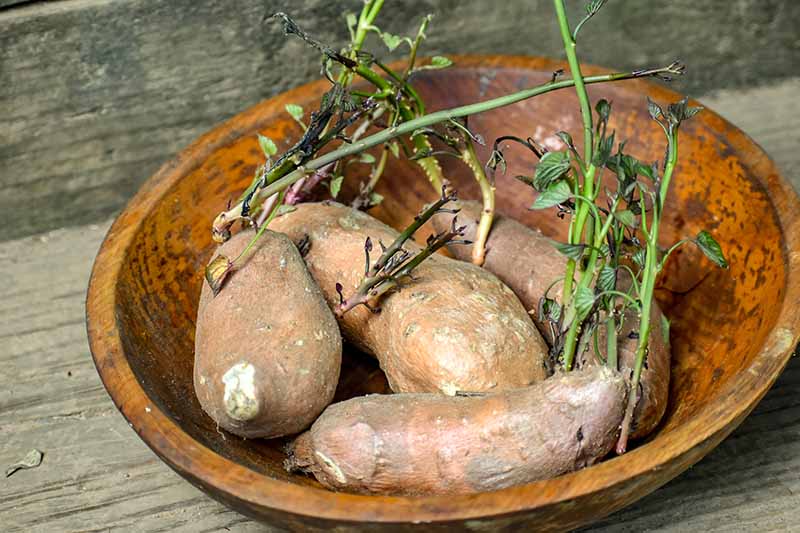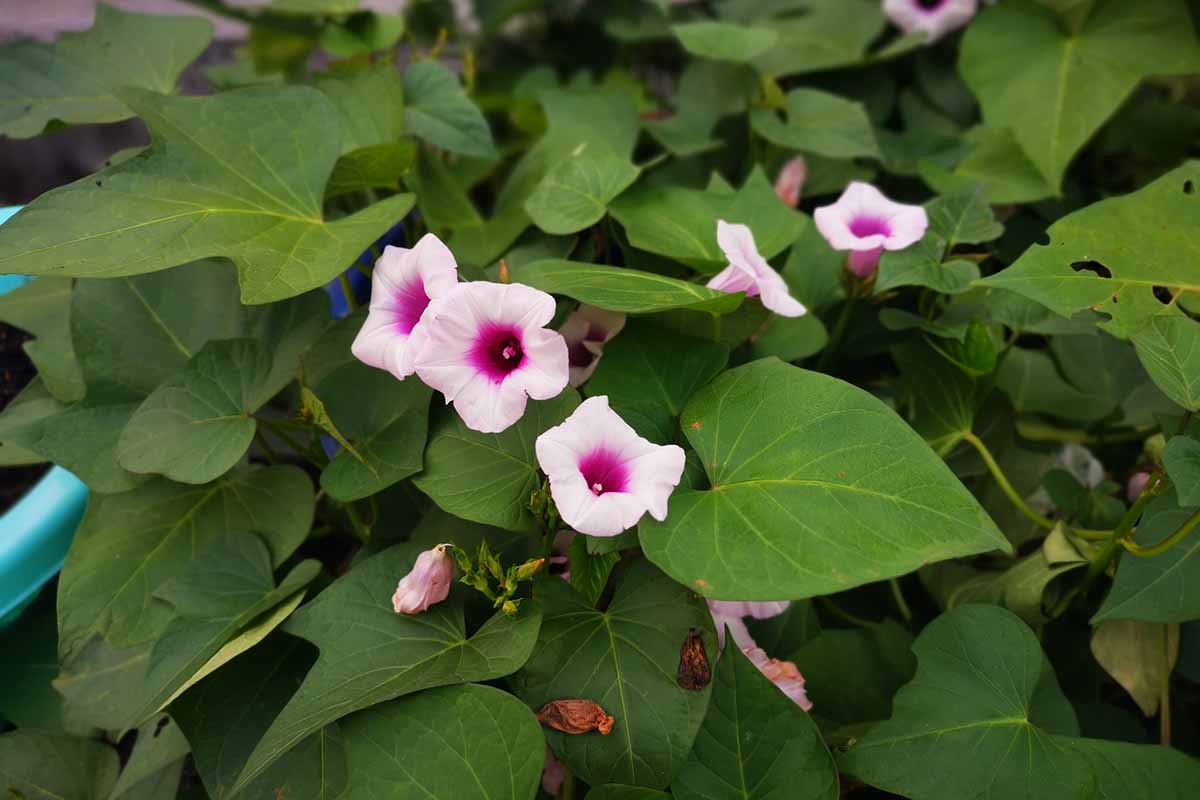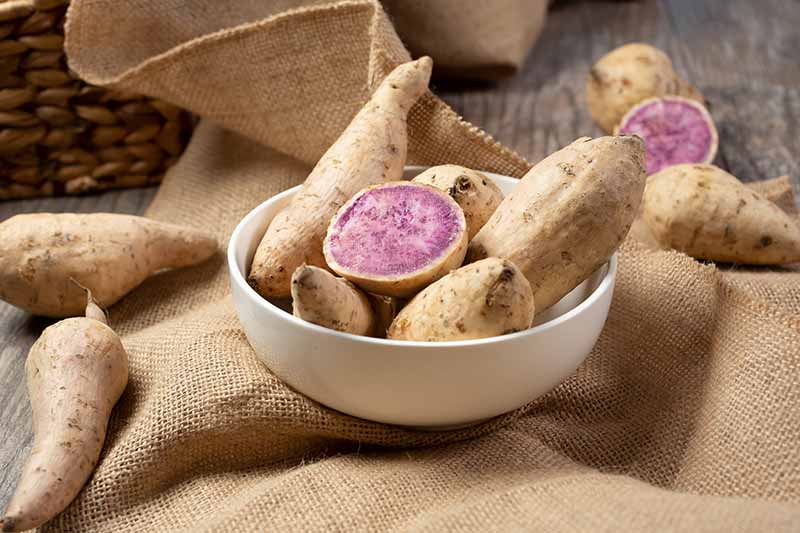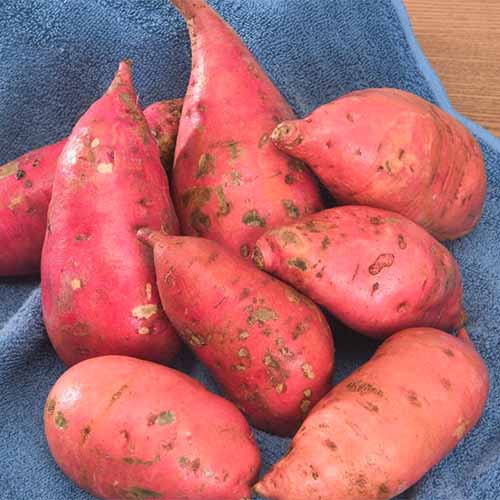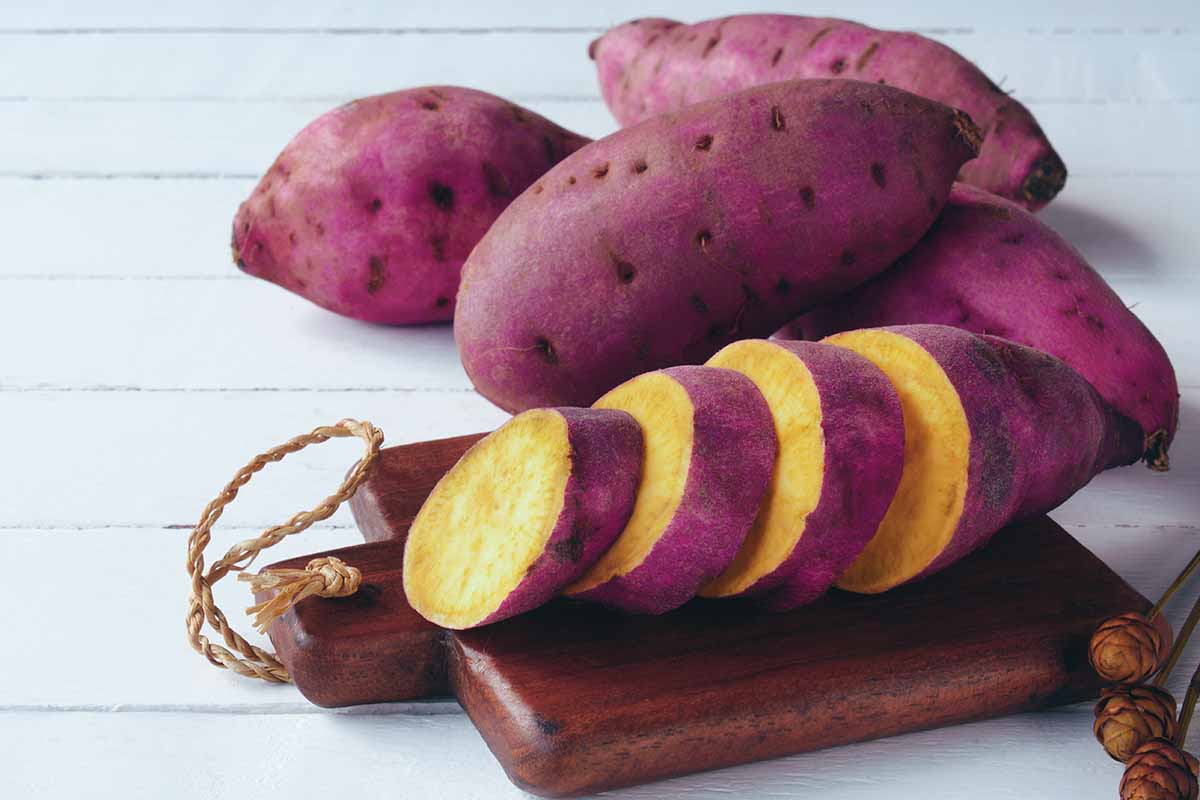Friends, my dear family member is wrong. Just about every sweet potato you see at the store – especially the orange ones – is a true sweet potato, also called “sweetpotato,” botanical name Ipomoea batatas. True yams, on the other hand, belong to the Dioscorea genus. We link to vendors to help you find relevant products. If you buy from one of our links, we may earn a commission. These root crops are a worthy addition to any garden that can grow them. They thrive in Zones 6 through 12 but some varieties can grow in cooler zones with adequate support. Or, I should say, with added warmth. You can learn all about growing them in our guide. Most likely cultivated thousands of years ago from wild plants in Central or South America, the sweet potato loves warm weather. Like its distant relative, the potato (Solanum tuberosum), I. batatas are rich in nutrients. They are an excellent source of vitamin A, especially the orange varieties, and a good source of fiber, potassium, and vitamin B6. These nutritious, tuberous roots come in many colors and various levels of sugariness. Are you ready to meet 21 delicious varieties to grow at home? Let’s get started! Before we dive into the list, here’s a bit of pertinent information about the sweet potato. On average, these tuberous roots grow four to six inches long, although they can be longer or shorter depending on the growing area and the time of harvest. Speaking of harvest times, the number of days to maturity described below indicate the number of days to harvest after planting a “slip,” which is a baby plant or shoot propagated from a parent root. The average vine spread is 36 to 48 inches, and the average height is six to 10 inches. All the varieties recommended below grow to around this size unless I note that they are “bush” varieties. Unlike typical vining varieties, bush types are more compact and therefore better suited to small gardens or growing in containers. Also, if you grow I. batata, you can eat the leaves in a salad. They’re nontoxic and reportedly delicious! And if you happen to get flowers, you’ll feel like you’re looking at a morning glory bloom, because… …you kinda are. They’re incredibly similar. Amazing, right? Without further ado/obsession about how pretty, tasty, and fantastic these plants are, let’s meet 21 of the best sweet potato varieties ever!
1. Bayou Belle
If you love the flavor of orange sweet potatoes but don’t love how mushy they get after cooking, try ‘Bayou Belle.’ This belle-of-the-garden has purplish-red skin and orange flesh, and it’s super sugary. Best of all, it remains firm after cooking! Bred specifically for this feature by Don La Bonte, an expert breeder with the Louisiana State University AgCenter, ‘Bayou Belle’ was released in 2011. ‘Bayou Belle’ has firm flesh that makes her an ideal candidate for one of my favorite side dishes of all time: sweet potato fries. For an exciting twist on regular fried sugary spuds, try this recipe for Cajun, oven-baked sweet potato fries from our sister site, Foodal. ‘Bayou Belle’ matures in 110 to 120 days and is resistant to the notorious southern root-knot nematode, along with soil rot, rhizopus soft rot, fusarium root rot, and fusarium wilt. With its rose-colored skin, orange flesh, and lightly sugared flavor, this moist cultivar makes delicious sweet potato fries that aren’t too sugary for the people in your home who prefer savory foods. Developed by horticulturists at the Louisiana State University AgCenter in 1987 to excel in Louisiana’s hot, humid growing conditions, commercial favorite ‘Beauregard’ has rose-colored skin and deep orange flesh. ‘Beauregard’ Good for storage, ‘Beauregard’ is sweet, moist, and slightly stringy, and it makes a fabulous pie. This early cultivar matures in 90 to 100 days and is resistant to streptomyces soil rot and fusarium wilt, but is susceptible to root-knot nematodes. You can purchase sets of 12 or 25 bare roots, aka “slips,” from Burpee.
3. Burgundy
True to its name, ‘Burgundy’ features pretty red skin and deep orange flesh that’s so sweet you won’t need to add any sugar – even if you’re baking a pie! Another offering from the Louisiana State University AgCenter, ‘Burgundy’ was released in 2014 and is resistant to soil rot, southern root-knot nematodes, and fusarium wilt. It is, however, susceptible to rhizopus soft rot and bacterial soft rot. This excellent cultivar matures in 100 to 120 days and makes a lovely casserole.
4. Centennial
Do you want to grow a high-yielding old favorite among American farmers? Try ‘Centennial,’ an heirloom semi-bush variety introduced by the Louisiana Agricultural Experiment Station in the early ‘60s that provides a moist, sugary flavor and perfectly orange skin and flesh. ‘Centennial’ matures in 100 to 110 days, so it’s an early variety suited to northern climates, and the tubers store well. ‘Centennial’ It is resistant to wireworms and guava root-knot nematodes as well as bacterial root rot and wilt, but may be susceptible to other diseases. Still, it is a worthy I. batata variety that cooks, bakes, fries, mashes, and pies well. (Is “pies” a verb? If not, it totally should be.) Purchase sets of 12 or 25 slips from Burpee and get started on your own miniature sweet potato farm. Harvest plants in 90 days for tasty, tender “baby bakers” that’ll make your mouth water.
5. Covington
Back in 2005, the North Carolina Agricultural Research Service released a new variety named ‘Covington’ after the late Henry M. Covington, an esteemed sweet potato scientist at North Carolina State University. Plus, it’s resistant to russet crack, root-knot nematodes, fusarium wilt, and streptomyces soil rot. ‘Covington’ matures in 95 to 110 days.
6. Evangeline
One of the quickest and easiest ways to enjoy a sweet potato is to pierce the skin with a fork and pop it in the microwave for about five minutes. This is a trick I learned in college, and if you want to pass the wisdom on to your college-bound acquaintances, hand them a bunch of homegrown ‘Evangeline’ sweet potatoes first. ‘Evangeline’ is a delightful, super-sugary treat with reddish-rose skin and deep orange flesh. The Louisiana State University AgCenter developed ‘Evangeline’ in 2008 to taste sweeter than ‘Beauregard’ and to have better nematode resistance. ‘Evangeline’ is resistant to soil rot, fusarium wilt, rhizopus soft rot, and fusarium root rot, and highly resistant to southern root-knot nematodes. This cultivar is susceptible to sclerotial blight. ‘Evangeline’ takes 100 to 120 days to mature.
7. Garnet
With skin as red as the gemstone it’s named for, ‘Garnet’ is an early to mid-season variety known for its sweet, moist, orange flesh. It tastes lovely when grated on a salad or sliced into fries. Popular among gardeners and cooks alike, ‘Garnet’ was one of the first “yam-like” varieties with orange flesh introduced to the US market, and it was often mislabeled as such at grocery stores in the mid-20th century. Today, though there’s some confusion surrounding this, it seems to also be referred to as ‘Diane.’ This variety probably doesn’t have the same disease and pest-resistance qualities as newer cultivars, but it’s a tasty staple in the sweet potato world. ‘Garnet’ is ready for harvest 110 days after planting. I love roasting ‘Hannah’ potatoes with red bell peppers, onions, leeks, and carrots for a filling and wholesome side dish. An early variety, ‘Hannah’ matures in about 110 days. We may not be able to turn up the heat, but with ‘Georgia Jet,’ we only need to wait 90 to 100 days ‘til she’s ready for picking. ‘Georgia Jet’ ‘Georgia Jet’ has reddish-purple skin and moist, sweet, orange flesh. So, Northern gardeners, rejoice: this heirloom is the rapidly growing type we can squeeze into our short summers and serve for fall festivities. This early variety is susceptible to soft rot and cracking. To get started, purchase a set of 12 or 25 slips from Burpee.
9. Hannah
If you’ve been reading this roundup just waiting for a cream-fleshed variety, I present ‘Hannah,’ one of the best cultivars for those who don’t care for the super-sugary orange varieties. With light, pinkish-tan skin and cream-colored flesh, ‘Hannah’ pleases the palate with her dry, flaky, dense texture and subtle sweetness.
10. Heart O’Gold
For a variety that’s tan with a heart of gold, try… well… ‘Heart O’Gold.’ With sugary, milky, golden flesh, this is another Louisiana State University AgCenter offering that’s been satisfying hungry diners since 1948. ‘Heart O’Gold’ (or ‘Heartogold’) makes an excellent fry or chip, and it lends itself well to baking, mashing, and roasting, too. Maturing in just 100 days, this early variety is susceptible to many I. batata pests and diseases, but it is resistant to root-knot nematodes.
11. Hernandez
‘Hernandez’ is known for its smooth, sweet flavor and its resistance to common sweet potato problems, such as fusarium wilt, root-knot nematodes, soil rot, and internal cork. With reddish-brown skin and deep orange flesh, this heirloom variety is a solid choice for anyone with a slightly picky eater on their hands. (Do you see me waving my hand?) Thanks to its smooth flesh, ‘Hernandez’ doesn’t have any of the strings that the youngest of foodies might not love. Developed by – you guessed it – the Louisiana State University AgCenter in 1992, this mid-season cultivar is ready for harvest in 125 days.
12. Jewel
With its copper-colored skin and dark orange flesh, ‘Jewel’ is a gem, indeed. Sweet, soft, and moist, ‘Jewel’ was developed at the North Carolina Ag Center in 1970. A mid-season semi-bush variety, this cultivar matures in 120 to 135 days. That may seem like a long time, but it’s well worth the wait, and you’re not likely to experience many issues. ‘Jewel’ is resistant to fusarium wilt, root-knot nematodes, sweet potato beetles, and internal cork. This variety also stores well. ‘Jewel’ is perfect for turning into chips or fries. If you’re feeling adventurous, try this recipe for sweet potato gnocchi with sage brown butter sauce from our sister site, Foodal.
13. Korean Purple
‘Korean Purple’ has such gorgeous, jewel-toned, purple skin that you won’t be able to stop staring at it. The creamy-white flesh of this heirloom is super-sweet, dry, and fluffy when cooked. It may remind you of cotton candy. Or marshmallows, maybe. With moderate pest and disease resistance, ‘Korean Purple’ matures in about 120 to 135 days and makes a tasty, colorful sweet potato fry.
14. Mahon Yam
The ‘Mahon Yam’ may carry “yam” in its name but it is not truly a yam at all. Instead, it’s a pretty sweet potato with pink skin and extremely sugary, smooth, orange flesh. An old heirloom patented by horticulturist John A. Mahon in Chesterfield, South Carolina, and released in 2008, ‘Mahon Yam’ is ideal for picky eaters because of its stringless flesh. It’s also a smart pick for Northern gardeners because it matures in just 90 days, and the tubers store well. The vines feature distinct, seven-lobed leaves. Back in the 1930s and ‘40s, ‘Nancy Hall’ went by the name “yellow yam,” thanks to its tan skin and yellow flesh.
15. Murasaki
Are you looking for an I. batata cultivar that’s pleasing to the eye and the tongue? ‘Murasaki’ boasts bright purple skin and cream-colored flesh that’s flaky, nutty, and slightly sweet. My mouth is watering just thinking about roasting a ‘Murasaki’ with a bounty of other veggies. ‘Murasaki’ Released by the ever-prolific Louisiana State University AgCenter in 2008, ‘Murasaki’ is highly resistant to root-knot nematodes and fusarium soil rot. It’s also resistant to rhizopus soft rot, fusarium wilt, and soil rot. If you love visually striking veggies, you won’t want to miss out on ‘Murasaki,’ which matures in 100 to 120 days. Find sets of 12 or 25 slips online from Burpee.
16. Nancy Hall
A moist and sweet midseason heirloom variety, ‘Nancy Hall’ matures in 110 to 120 days and makes a delectable addition to any pie, mash, or fry. This type stores well though it is noted as being susceptible to black rot and stem rot, so be sure to rotate your crops. ‘Nancy Hall’ has a storied past, too. Legend has it that this variety came about after a young gardener named Nancy Hall accidentally crossed flower seeds with a potato, resulting in a sweet potato. An implausible story, but a fun one nonetheless.
17. O’Henry
If you’re not one for sweet, moist root veggies, try ‘O’Henry.’ With dry, sweet, cream-colored flesh and yellow-tan skin, ‘O’Henry’ is thought to be a natural mutation of ‘Beauregard.’ Henry Wayne Bailey of Cane Creek Farms in Vardaman, Mississippi, discovered it and ‘O’Henry’ went out to commercial markets in the 1990s. ‘O’Henry’ has similar pest and disease resistance qualities as its parent plant, ‘Beauregard.’ It is resistant to streptomyces soil rot and fusarium wilt, but susceptible to root-knot nematodes. ‘O’Henry’ is an early variety, ready for picking about 100 days after planting.
18. Okinawan
There’s nothing I love more than a sweet potato that looks plain on the outside, but then when you cut it open, you discover something entirely unexpected. If you grow ‘Okinawan,’ also known as ‘Okinawa Purple,’ you’ll harvest tan or buff-colored sweet potatoes that don’t look like anything special. But then, you’ll slice them open, and the striking, bright-purple flesh will amaze you. The flavor and texture of this late heirloom variety is luscious, too: slightly sweet, dense, and starchy, so they’re perfect for fries, savory dishes, and salads. ‘Okinawan’ matures in 120 to 180 days and is well worth the wait. Carried from Central and South America by Spanish colonists to China and the Philippines in the 15th century, by the 1600s, purple sweet potatoes made their way to Japan and were initially planted in Okinawa Prefecture. Once eaten out of necessity instead of rice, the tubers became known as a staple of Okinawan diets for hundreds of years, and the region is known in modern times for its long-lived inhabitants. Nowadays, ‘Okinawan’ is also grown commercially in Hawaii, where rich volcanic soils enhance their anthocyanin-rich purple flesh, and shipped to the mainland for sale. A mutation from a regular vine discovered at the Georgia Coastal Plain Experiment Station, ‘Porto Rico’ is a bush variety, which means rather than sprawling outward, it grows upward. ‘Porto Rico’ grows about 12 to 30 inches tall with an upward-growing spread of two to three feet. You can plant each slip 12 to 15 inches away from other plants in the garden, including other bush ‘Porto Rico’ plants. ‘Porto Rico’ With copper-colored skin and salmon flesh, ‘Porto Rico’ is sweet and light, ideal for making chips and fries or baking and serving with butter. It’s harvest-ready in 110 days and is resistant to fusarium rot, but is susceptible to most other sweet potato pests and diseases. You can purchase a bag of 12 slips from the Home Depot.
20. Sumor
‘Sumor’ has an interesting claim to fame: it tastes almost exactly like a standard white-fleshed potato, and stores well. Botanically, it’s an I. batata plant, though you can use it interchangeably with Irish potatoes in a pinch. ‘Sumor’ potato soup, anyone? The skin is tan, with yellow or white flesh inside. ‘Sumor’ is an early variety that matures in 110 to 120 days and features robust disease and pest resistance. It’s resistant to fusarium wilt, stem rot, root-knot nematodes, and more. Fun fact: It’s named for the old English word for “summer.” This is one fascinating potato, if you ask me.
21. Vardaman
Did you know that Vardaman, Mississippi, is the Sweet Potato Capital of the World? For 48 years now, the town has hosted the Vardaman Sweet Potato Festival, a celebration that includes a 5k run, arts and crafts, and plenty of flavorful I. batata dishes. The Mississippi Agricultural Extension Service released ‘Vardaman’ in 1981, naming it for the famed Mississippi town. Maturing in about 100 days, mid-season ‘Vardaman’ boasts sugary, smooth, orange flesh. It’s another bush variety, making it perfect for gardeners with limited space. ‘Vardaman’ It grows to about 12 to 30 inches tall and two to three feet wide, although it can be planted just 12 to 15 inches from other ‘Vardaman’ plants. ‘Vardaman’ is susceptible to root-knot nematodes and soil insects, but it is resistant to fusarium wilt. You can purchase sets of 12 or 25 slips from Burpee.
Make a Batata Frittata (Or Whatever You Want!)
So, friends: what will you do with the I. batata cultivars you grow? Which ones make you the most eager to get started? If I lived in a warmer hardiness zone, I’d be growing ‘Okinawan’ for sure. But since I’m in Alaska, I’ll stick with ‘Georgia Jet’ and ‘Mahon Yam,’ which is wonderful too. Have you ever grown and harvested I. batata before? Which cultivar is your favorite? Share your questions and stories in the comments below. And remember to check out these root-veggie roundups, too:
13 of the Best Carrot Varieties to Grow at Home25 of the Best Radish Varieties for Your Veggie GardenTop 17 Beet Varieties to Plant This Season

